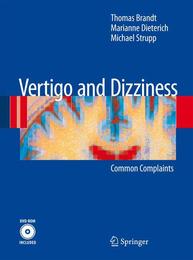Beschreibung
Inhaltsangabe1 INTRODUCTORY REMARKS 1.1 Vertigo or dizziness: multisensory syndromes 1.2 Patient history 1.3 Neuroophthalmological and neurootological examination 1.4 Apparative examinations 1.4.1 Electronystagmography (ENG) 1.4.2 Videooculography 1.4.3 Neuroorthoptic and psychophysical procedures 1.4.4 Audiometry 1.4.5 Other additional apparative examinations 1.4.6 Imaging of the petrous bone, the cerebellopontine angle, and the brainstem by means of computed tomography and magnetic resonance imaging 1.5 General principles of therapy 2 PERIPHERAL VESTIBULAR FORMS OF VERTIGO 2.1 Benign paroxysmal positioning vertigo (BPPV) 2.1.1 Patient history 2.1.2 Clinical features and course 2.1.3 Pathophysiology and therapeutic principles 2.1.4 Pragmatic therapy 2.1.5 BPPV of the horizontal canal (h-BPPV) 2.1.6 Differential diagnosis and clinical problems 2.1.7 Central positional vertigo / nystagmus 2.2 Vestibular neuritis (acute partial unilateral vestibular failure) 2.2.1 Patient history 2.2.2 Clinical features and course 2.2.3 Pathophysiology and therapeutic principles 2.2.4 Pragmatic therapy 2.2.5 Differential diagnosis and clinical problems 2.3 Menière's disease 2.3.1 Patient history 2.3.2 Clinical syndrome and course 2.3.3 Etiology, pathophysiology, and therapeutic principles 2.3.4 Pragmatic therapy 2.3.5 Differential diagnosis and clinical problems 2.4 Vestibular paroxysmia 2.4.1 Patient history 2.4.2 Clinical aspects and course 2.4.3 Etiology, pathophysiology, and therapeutic principles 2.4.4 Pragmatic therapy 2.4.5 Differential diagnosis and clinical problems 2.5 Bilateral vestibulopathy 2.5.1 Patient history 2.5.2 Clinical aspects and natural course 2.5.3 Etiology, pathophysiology, and therapeutic principles 2.5.4 Pragmatic therapy 2.5.5 Differential diagnosis and clinical problems 2.6 Perilymph fistulas 2.6.1 Patient history 2.6.2 Clinical aspects and course 2.6.3 Pathophysiology and therapeuticprinciples 2.6.4 Pragmatic therapy 2.6.5 Differential diagnosis and clinical problems 3 CENTRAL VESTIBULAR FORMS OF VERTIGO 3.1 Central vestibular syndromes 3.1.1 Clinical aspects, course of disease, pathophysiology, and therapeutic principles 3.1.2 Central vestibular syndromes in the three planes of action of the vestibulo-ocular reflex 3.2 Basilar migraine / vestibular migraine 3.2.1 Patient history 3.2.2 Clinical aspects and course 3.2.3 Pathophysiology and therapeutic principles 3.2.4 Pragmatic therapy 3.2.5 Ineffective treatments 3.2.6 Differential diagnosis and clinical problems 4 TRAUMATIC FORMS OF VERTIGO 4.1 Traumatic peripheral vestibular dizziness 4.2 Traumatic central vestibular forms of vertigo 4.3 Traumatic cervical vertigo 4.4 Posttraumatic psychogenic vertigo 5 PSYCHOGENIC FORMS OF VERTIGO AND DIZZINESS 5.1 Phobic postural vertigo 5.1.1 Patient history 5.1.2 Clinical aspects and course of the illness 5.1.3 Pathophysiology and therapeutic principles 5.1.4 Pragmatic therapy 5.1.5 Differential diagnosis and clinical problems 6 VARIOUS VERTIGO SYNDROMES 6.1 Vertigo / dizziness in childhood and hereditary vertigo syndromes 6.1.1 Benign paroxysmal vertigo of childhood 6.1.2 Familial episodic ataxia types 1 and 2 6.1.3 Motion sickness 6.2 Druginduced vertigo 6.3 Cervicogenic vertigo 6.4 Motion sickness 6.4.1 Clinical aspects and pathogenesis 6.4.2 Course and therapy 6.4.3 Pragmatic therapy 6.5 Height vertigo 6.5.1 Syndromal aspects and pathogenesis 6.5.2 Course and therapy Index List of videos
Inhaltsverzeichnis
1INTRODUCTORY REMARKS 1.1Vertigo or dizziness: multisensory syndromes 1.2Patient history 1.3Neuro-ophthalmological and neuro-otological examination 1.4Apparative examinations 1.4.1Electronystagmography (ENG) 1.4.2Video-oculography 1.4.3Neuro-orthoptic and psychophysical procedures 1.4.4Audiometry 1.4.5Other additional apparative examinations 1.4.6Imaging of the petrous bone, the cerebellopontine angle, and the brainstem by means of computed tomography and magnetic resonance imaging 1.5General principles of therapy 2PERIPHERAL VESTIBULAR FORMS OF VERTIGO 2.1Benign paroxysmal positioning vertigo (BPPV) 2.1.1Patient history 2.1.2Clinical features and course 2.1.3Pathophysiology and therapeutic principles 2.1.4Pragmatic therapy 2.1.5BPPV of the horizontal canal (h-BPPV) 2.1.6Differential diagnosis and clinical problems 2.1.7Central positional vertigo / nystagmus 2.2Vestibular neuritis (acute partial unilateral vestibular failure) 2.2.1Patient history 2.2.2Clinical features and course 2.2.3Pathophysiology and therapeutic principles 2.2.4Pragmatic therapy 2.2.5Differential diagnosis and clinical problems 2.3Meniere¿s disease 2.3.1Patient history 2.3.2Clinical syndrome and course 2.3.3Etiology, pathophysiology, and therapeutic principles 2.3.4Pragmatic therapy 2.3.5Differential diagnosis and clinical problems 2.4Vestibular paroxysmia 2.4.1Patient history 2.4.2Clinical aspects and course 2.4.3Etiology, pathophysiology, and therapeutic principles 2.4.4Pragmatic therapy 2.4.5Differential diagnosis and clinical problems 2.5Bilateral vestibulopathy 2.5.1Patient history 2.5.2Clinical aspects and natural course 2.5.3Etiology, pathophysiology, and therapeutic principles 2.5.4Pragmatic therapy 2.5.5Differential diagnosis and clinical problems 2.6Perilymph fistulas 2.6.1Patient history 2.6.2Clinical aspects and course 2.6.3Pathophysiology and therapeutic principles 2.6.4Pragmatic therapy 2.6.5Differential diagnosis and clinical problems 3CENTRAL VESTIBULAR FORMS OF VERTIGO 3.1Central vestibular syndromes 3.1.1Clinical aspects, course of disease, pathophysiology, and therapeutic principles 3.1.2Central vestibular syndromes in the three planes of action of the vestibulo-ocular reflex 3.2Basilar migraine / vestibular migraine 3.2.1Patient history 3.2.2Clinical aspects and course 3.2.3Pathophysiology and therapeutic principles 3.2.4Pragmatic therapy 3.2.5Ineffective treatments 3.2.6Differential diagnosis and clinical problems 4TRAUMATIC FORMS OF VERTIGO 4.1Traumatic peripheral vestibular dizziness 4.2Traumatic central vestibular forms of vertigo 4.3Traumatic cervical vertigo 4.4Post-traumatic psychogenic vertigo 5PSYCHOGENIC FORMS OF VERTIGO AND DIZZINESS 5.1Phobic postural vertigo 5.1.1Patient history 5.1.2Clinical aspects and course of the illness 5.1.3Pathophysiology and therapeutic principles 5.1.4Pragmatic therapy 5.1.5Differential diagnosis and clinical problems 6 VARIOUS VERTIGO SYNDROMES 6.1 Vertigo / dizziness in childhood and hereditary vertigo syndromes 6.1.1Benign paroxysmal vertigo of childhood 6.1.2Familial episodic ataxia types 1 and 2 6.1.3Motion sickness 6.2Drug-induced vertigo 6.3Cervicogenic vertigo 6.4Motion sickness 6.4.1Clinical aspects and pathogenesis 6.4.2Course and therapy 6.4.3Pragmatic therapy 6.5Height vertigo 6.5.1Syndromal aspects and pathogenesis 6.5.2Course and therapy Index List of videos





































































































